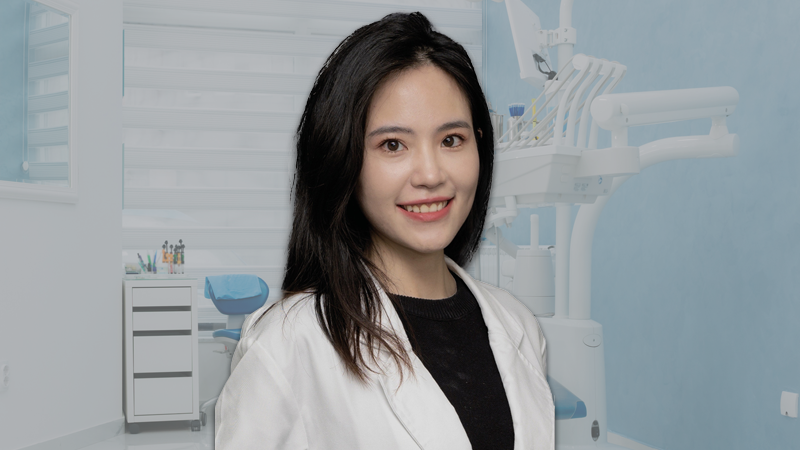
Earlier this year, it was announced that N Movina Wu from National Cheng Kung University won first place at the Global Clinical Case Contest (GCCC) 2023-2024 with her case involving a fractured upper right central incisor. The Dentsply Sirona GCCC is a worldwide competition for dental students to present clinically challenging restorations using Dentsply Sirona products. Oral Health had the chance to interview Movina on her experience for Next Gen of the Month, a monthly Q&A with a dental student or new dentist where we ask them about their experiences and accomplishments thus far in their dentistry journey.
Can you tell us a little about your journey in dentistry? What inspired you to pursue this field?
I have always been fascinated with art when I was growing up. As a kid, I loved to paint, sketch, and do all sorts of hands-on craft. However, having a father who’s a doctor, I was always expected to pursue a career in the healthcare field. Ultimately, being a dentist seems to be the perfect answer to that.
What motivated you to focus on restorative work, particularly minimally invasive techniques?
Living in Tainan, where riding a scooter is one of the most common modes of transportation, unfortunately, we receive a lot of trauma cases at the Emergency Room. The psychological trauma patients must endure from the events is heartbreaking. Being able to make a small contribution to their treatment plan and help restore their confidence through my restorative work has been rewarding. The use of minimally invasive techniques has also allowed more preservation of sound tooth structure and less discomfort for the patient.
How did you prepare for the competition, and what was the experience like?
After first meeting the patient and discussing the treatment options with him, I knew he would be a challenging yet rewarding case for the competition. I started with a wax-up to help me visualize the restoration result. Throughout my training at the restorative department, I received a lot of encouragement and feedback from Dr. Shu-fen Chuang and Dr. Ting-wen Lai. They had given me books to familiarize me with the layering technique. Therefore, with Dentsply Sirona’s innovative resin materials, I was able to mimic the characteristics of the patient’s natural teeth on my restoration. The competition itself was an amazing experience; I have learned so much from being surrounded by motivated and talented young dentists. I would highly recommend it to everyone!
What specific challenges did you face during the competition, and how did you overcome them?
One of the biggest challenges was the fact that my patient’s front teeth were misaligned and crowded. Since the patient did not want to have orthodontic treatment, I wanted to try to harmonize the misalignment through my restorative work. I used a wax-up to allow better visualization and refined my final restoration using fine-grit diamond burs for the shape and form of the tooth.
Minimally invasive techniques are gaining traction in dentistry. What excites you most about this approach to restorative work?
Minimally invasive dentistry focuses on preserving as much natural tooth structure as possible. What excites me most about this approach is how it transforms patient care. Indeed, the use of advanced materials such as Dentsply Sirona’s Neo Spectra® ST composites allow for increased precision and control, supporting restorations that are reliably durable, stain resistant, and blend seamlessly into the tooth. These materials provide an excellent handling and adapt to the cavity’s shape, minimizing the need for excessive tooth preparation.
With this approach, the result is more likely esthetically pleasing and healthier for the patient in the long term, as we’re safeguarding more of their natural dentition. And a happy and healthy patient means a happy dental professional.
What are some of the key advantages of minimally invasive techniques for both patients and practitioners?
Minimally invasive techniques benefit patients by reducing discomfort, lowering the risk of post-operative sensitivity, and maintaining more of their natural tooth structure.
From a practitioner’s standpoint, these techniques allow for more conservative treatment planning. With Dentsply Sirona materials, such as DeTrey Conditioner® for etching and Prime&Bond® Universal Adhesive for bonding, we can work efficiently and effectively with high-quality materials that adhere well and last longer. Furthermore, chances are better that patients enjoy shorter recovery times and esthetically pleasing, natural-looking restorations, which leads to higher satisfaction.
Are there any emerging trends or innovations in minimally invasive dentistry that you find particularly promising?
In my opinion, one of the most promising innovations is the development of universal composite materials that can be adapted to various cavity sizes with minimal preparation.
The Neo Spectra® ST composites, for instance, offer excellent versatility and simplicity. Its innovative SphereTEC® Filler Technology provides exceptional handling characteristics and chameleon effect, which makes it an excellent choice for minimally invasive procedures.
Can you share your insights on the latest innovations in composite materials? How do they impact durability, esthetics, or patient comfort?
Recent innovations in composite materials have significantly improved outcomes in restorative dentistry. Products like Neo Spectra® ST composites are designed to offer both durability and exceptional esthetics. They feature spherical shaped filler technology that supports high polish retention and resistance to wear, which is crucial for both functional longevity and maintaining the esthetic look of restorations over time.
Moreover, the distinct chameleon effect allows for a simplified shade system consisting of just five CLOUD™ shades as well as two dentin and one enamel shades for a simplified layering technique. The already mentioned handling properties ease and accelerate placement, which benefits both the patient and the practitioner.
What role did the choice of materials play in your award-winning restorative work during the competition?
Restoring a Class IV defect using direct composite offers the advantage of conserving more of the natural tooth structure while being a more cost- effective option. However, it can present clinical difficulties, particularly when it comes to selecting and applying the right restorative materials. A thorough understanding of the materials’ properties is essential for effectively manipulating composite layers to create a natural, esthetically pleasing result.
The choice of materials was integral to the success of my restorative work. I utilized the Neo Spectra® ST composites simplified layering technique.
The composite provided the ideal blend of excellent adaptation and handling with natural esthetics. Combined with Prime&Bond® Universal Adhesive for exceptional adhesion and Enhance Finishing® and Prisma Gloss® for a smooth, high-gloss finish, these materials ensured the restoration was both functionally robust and visually indistinguishable from the surrounding tooth structure.
The precision and quality of these materials enabled me to achieve superior results that met both the functional and esthetic criteria of the competition.
For students or young professionals looking to excel in restorative work, what advice would you give based on your experiences?
I would say take lots of pictures. By taking pictures after each step, it has allowed me to reflect on my restoration process and facilitate discussion with my mentors and colleagues. Also, sometimes there are minute details that get overlooked by the naked eyes. In this instance, the perikymata on my restoration was added at the 1-week follow-up after going through the photos and noticing distinct characteristics on my patient’s neighboring teeth.


